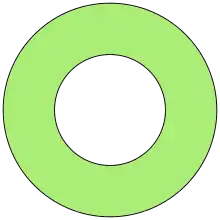Star domain
In mathematics, a set S in the Euclidean space Rn is called a star domain (or star-convex set, star-shaped set or radially convex set) if there exists an x0 in S such that for all x in S the line segment from x0 to x is in S. This definition is immediately generalizable to any real or complex vector space.

A star domain (equivalently, a star-convex or star-shaped set) is not necessarily convex in the ordinary sense.

An annulus is not a star domain.
Intuitively, if one thinks of S as of a region surrounded by a wall, S is a star domain if one can find a vantage point x0 in S from which any point x in S is within line-of-sight. A similar, but distinct, concept is that of a radial set.
Examples
- Any line or plane in Rn is a star domain.
- A line or a plane with a single point removed is not a star domain.
- If A is a set in Rn, the set obtained by connecting all points in A to the origin is a star domain.
- Any non-empty convex set is a star domain. A set is convex if and only if it is a star domain with respect to any point in that set.
- A cross-shaped figure is a star domain but is not convex.
- A star-shaped polygon is a star domain whose boundary is a sequence of connected line segments.
Properties
- The closure of a star domain is a star domain, but the interior of a star domain is not necessarily a star domain.
- Every star domain is a contractible set, via a straight-line homotopy. In particular, any star domain is a simply connected set.
- Every star domain, and only a star domain, can be "shrunken into itself"; that is, for every dilation ratio r < 1, the star domain can be dilated by a ratio r such that the dilated star domain is contained in the original star domain.[1]
- The union and intersection of two star domains is not necessarily a star domain.
- A non-empty open star domain S in Rn is diffeomorphic to Rn.
See also
References
- Drummond-Cole, Gabriel C. "What polygons can be shrinked into themselves?". Math Overflow. Retrieved 2 October 2014.
External links
| Wikimedia Commons has media related to Star-shaped sets. |
- Humphreys, Alexis. "Star convex". MathWorld.
This article is issued from Wikipedia. The text is licensed under Creative Commons - Attribution - Sharealike. Additional terms may apply for the media files.